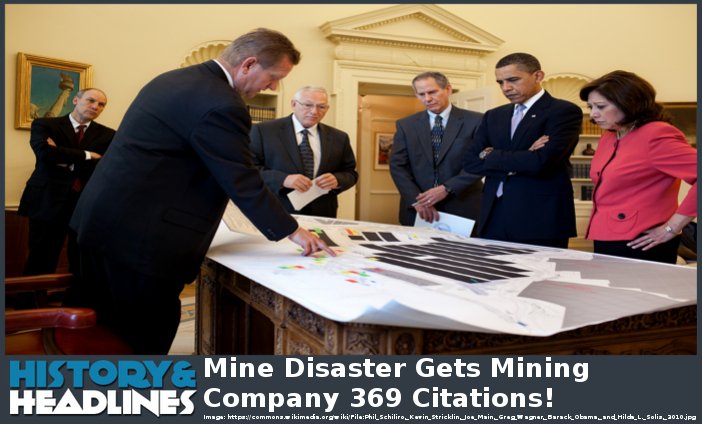A Brief History
On April 5, 2010, the Upper Big Branch coal mine in West Virginia suffered a collapse, killing 29 of the 31 men working at the site. The tragedy was the worst US mine disaster since 1970, and resulted in the Massey Energy Company being issued 369 citations for failing to follow proper mine safety laws.
Digging Deeper
Coal mining is hard, dirty work, and the miners are always at risk for catastrophic accidents and cave ins, especially when safety regulations are not followed exactly. Even without spectacular accidents, the long term effects of coal dust in the lungs has killed many thousands of miners. In this particular case, it was Alpha Natural Resources that paid the $10.8 million fine and settled the lawsuits from the families of victims for $209 million since Alpha had bought out Massey a year after the tragedy. Massey had been a large coal mining company, controlling about a third of all the coal resources in the Appalachian region and ranking 6th in the United States in annual coal production. Selling price to Alpha Natural Resources was a whopping $7.1 billion. Massey had a poor record of environmental and safety violations, exactly the reason why the Federal Government and the EPA had to enact all the various safety and environmental standards in effect.
Incredibly, at least to this author, Senator Rand Paul of Kentucky has stated his disdain for mine safety regulations, apparently caring more about the mining companies than the miners themselves. The idea that a company will adhere to safe practices because it is in the best interest of the company to do so is either naïve to the point of idiocy or a completely disingenuous lie. In real life, mining companies are notorious for violating safety and environmental rules.
Another hotly debated aspect of coal mining is the declining number of jobs related to the industry. In the United States, burning coal generates tremendous amounts of pollutants that power companies must deal with, while natural gas burns much cleaner. The boom in natural gas production due to the practice of “fracking” has made conversion of power plants to gas fired electricity producers the norm, greatly reducing the demand for coal in the US. Coupled with the ever-increasing mechanization and automation in coal mining, the loss of jobs in the mining industry is inevitable, even when demand for coal goes up periodically. This job loss due to modern mechanization has bedeviled American workers in many industries, notably in manufacturing and machining, as well as the automobile industry. When politicians promise out of work or underemployed miners that they will somehow generate a bunch of “high paying” mining jobs, they are either lying or do not understand the economics of coal mining.
Getting back to the Upper Big Branch disaster, the accident was caused by a massive explosion, possibly due to build of methane gas (natural gas), perhaps aggravated by coal dust. Rescue workers found 7 dead miners the first day and discovered the last 4 dead bodies 4 days later. Investigators found that inadequate ventilation was the reason for the dangerous build up of methane in the mine. The rescue effort had been massive, with more than 20 ambulances, 3 helicopters, and dozens of rescue workers pitching in. Company officials reported the mine had extensive safety features, such as “safe” area, pre-stocked oxygen tanks and food and water and other survival measures in case of an accident. The mine was being operated by a subsidiary of Massey, the Performance Coal Company.
Coal production in the United States is definitely decreasing, going from a relatively robust 1+ billion short tons in 2010 to only 705 million short tons in 2019. Sadly, for those families that rely on coal mining for their living, the industry is not in a growth mode and further layoffs seem inevitable. In fact, 5 of the top 6 coal mining companies in the United States have filed bankruptcy between 2016 (1 company) and 2019 (4 companies)! In case you wondered, West Virginia is the second largest producer of coal of the American states, trailing #1 Wyoming and ahead of #3 Pennsylvania. Would you be surprised to know that the fourth largest producer of coal in the United States is Illinois?
Question for students (and subscribers): Have you or any of your relatives ever worked in coal mines? Please let us know in the comments section below this article.
If you liked this article and would like to receive notification of new articles, please feel welcome to subscribe to History and Headlines by liking us on Facebook and becoming one of our patrons!
Your readership is much appreciated!
Historical Evidence
For more information, please see…
Freese, Barbara. Coal: A Human History. Basic Books, 2016.
Green, James. The Devil Is Here in These Hills: West Virginia’s Coal Miners and Their Battle for Freedom. Grove Press, 2016.
The featured image in this article, a photograph by Official White House Photograph from Washington, DC by by Pete Souza of President Barack Obama looking at a map of the Upper Big Branch mine, the site of a deadly explosion on April 5, spread across his desk in the Oval Office during a meeting on mine safety with, from left, Assistant to the President for Legislative Affairs Phil Schiliro, U.S. Mine Safety and Health Administrator Kevin Stricklin, Assistant Secretary of Labor for Mine Safety and Health Joe Main, Deputy Mine Safety and Health Administrator Greg Wagner, and Labor Secretary Hilda L. Solis, April 15, 2010, is a work of an employee of the Executive Office of the President of the United States, taken or made as part of that person’s official duties. As a work of the U.S. federal government, it is in the public domain.


